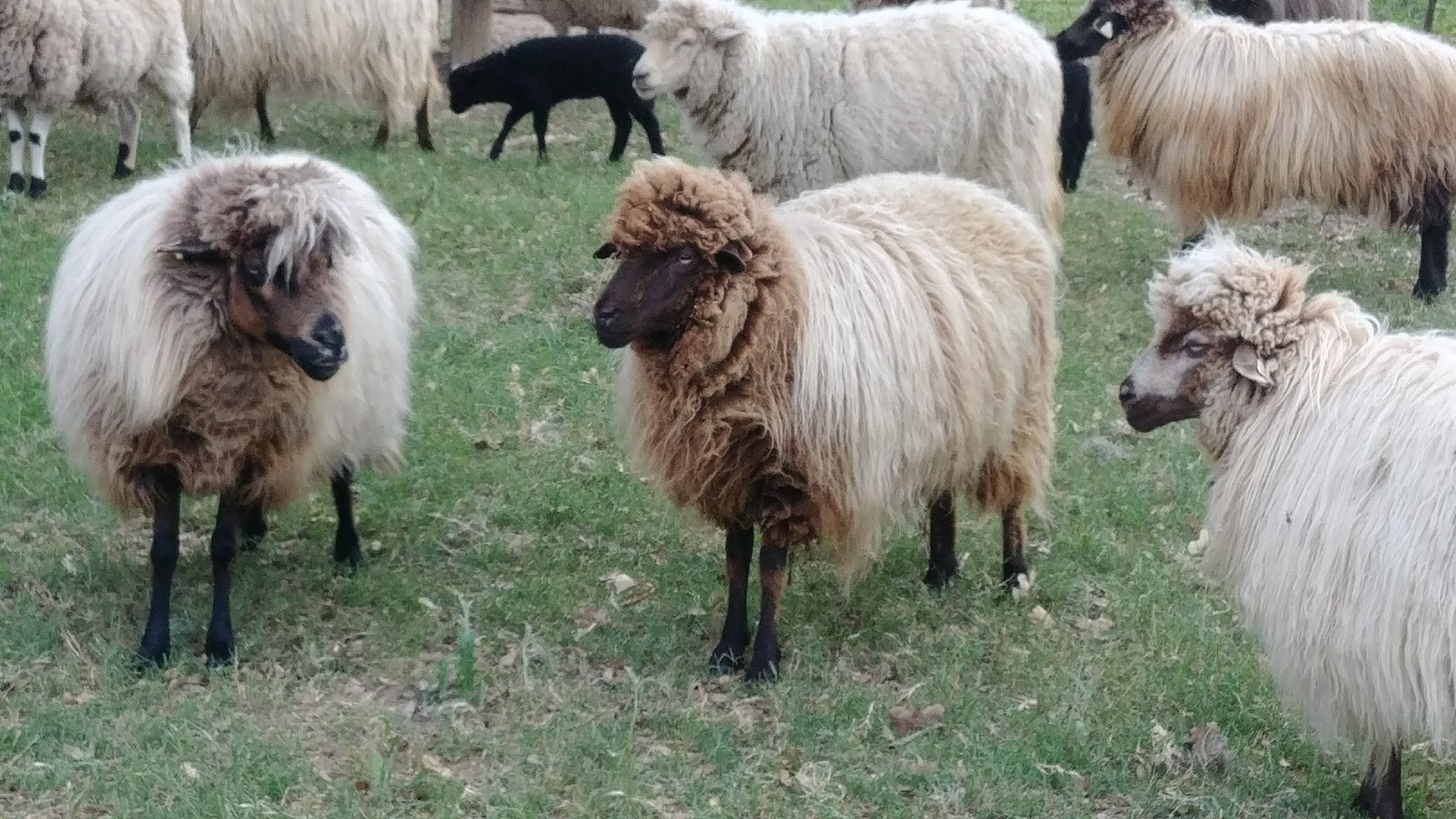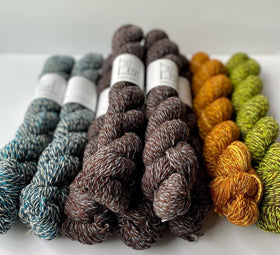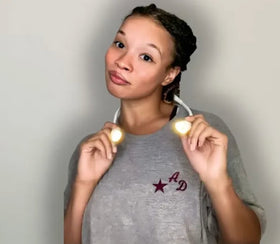
Meet the Maker: Monica of GothFarm Yarn!
We've been keeping this extra-special trunk show under wraps for long-enough! We are so thrilled to introduce Monica of GothFarm Yarns to our String Theory community - Learn more about the unique world of undyed yarn and heritage sheep breeds in this fascinating interview. As an added bonus, we decided to continue the conversation with Monica on our Youtube Channel - check it out!
You can peruse Monica's special yarns in-store and online from April 6-20 at String Theory Yarn Company. As always, shop early for the best selection!

How did you get into dyeing? Tell us your story.
The unique thing about my yarn is that it is undyed! Here’s the story of how Gothfarm got its start. Shortly after learning to knit a little over a decade ago, I started going to yarn festivals. I thought (and still think!) that the indie dyed yarns were beautiful. But I noticed a lack of variety in natural colors. The natural colors that were available were people’s own small flocks and were often from a single sheep breed. This inspired me to learn to spin and make my own yarn from a variety of different fibers. I loved the color and texture and color of these yarns and the process of going from raw fleece to finished yarn. I also enjoyed learning about the rich histories of different sheep breeds, some which were ancient and others relatively new.
I told my friend in passing that I would love to have a little “goth farm” that prioritized black sheep and other naturally colored animals so I could make more and more beautiful, unique yarns. Just saying that out loud got the wheels turning about a yarn business that could focus on these types of yarns.
I live in an apartment and work in a city, so a farm wasn’t in the cards anytime soon. But I could start buying fleeces from sheep raisers and working with mills to make the yarn a reality. That’s essentially how Gothfarm Yarn was born. I started the business in 2017 with three yarns. The process has stayed the same, I just have many more yarns to show for it!
What is your favorite part of the process?
My favorite part of the process is getting to work with people across the wool and fiber industry, from sheep raisers to small mills, to local yarn shops and festival organizers, to the people who use my yarn to make beautiful garments and works of fiber art. They are all linked together by wool and fiber but have such different cultures, lifestyles and journeys that brought them to what they’re doing.
But a close second is working with raw wool. There’s nothing better than spending a sunny day , digging into gorgeous wool locks on the skirting table, experiencing their texture and listening to what the fiber is telling me it wants to be.

Where do you get your inspiration?
My day job is in a geosciences department at a university. I get a lot of inspiration for my yarn names from the rocks and minerals that show up in research projects. Like the fiber I work with, they too often have unique colors, textures and stories. More broadly, I think I get the most inspiration from the tactile experience of working with different fibers. Most commercial yarn is very soft and very consistent. I like embracing yarn that can offer a bit more personality, whether it’s hairy and rugged, shiny and luminous, or a unique natural color. I also get inspiration from the broader fiber art community. I love how indie dyed colors can make my natural colors pop and I love projects where my yarn and dyed yarns can work harmoniously together, like my recently released Q 4000 sock kit. I’m also a big fan of works by Diné (Navajo) weavers. People in the Diné community have been working with Navajo-Churro sheep and cultivating natural colors of wool for generations. Their works bring out these colors and textures in beautiful ways. A few years ago I worked with Diné weaver Kevin Aspaas to create a Diné inspired motif for a Navajo Churro sweater. I wanted to bring weaving elements to the knitting world and I love the motif that Kevin designed. (It’s available for free on the Gothfarm yarn website).

Which sheep breed that you work with best represents your personality?
I love this question! My answer is unequivocally the Jacob Sheep. They are an ancient, eye-catching sheep with black-and-white spotted wool and multiple horns. For rams, these horns can reach huge proportions! Their wool has a medium feel and blends together to create a beautiful heathered gray that adds intrigue and depth to other fibers that are mixed into it. I guess I relate to them because they stand out! I’m a creative person and I want my projects to be eye-catching but approachable in the same way the sheep are.
Tell us about a WIP or a project in your queue that you're really excited about! Which of your yarns would you recommend for this (or these) project(s)?
I’m really excited about knitting a tiny buffalo, squirrel or badger from Sarah Elizabeth Kellner’s “Wild and Wooly Knitted Animals: A Naturalist’s Notebook!” I met Sarah at a yarn event a few years ago and fell in love with her lovingly designed and considered creatures. I think knitting them up with my Navajo-Churro yarns – which have a textured and furry look – would add another layer of life to them. I think a squirrel would look fabulous in Roan or Slate. I love that they’re generally one-skein projects too.

Of what you are sending us, what are your favorite colors or color combinations?
My favorite color is probably Carbonado. It’s an elegant, natural black that really stands out among natural yarns. It’s also a tri-blend yarn that really shows off the different characteristics of the fibers it’s made from. Its shine and slight halo come from Gotland sheep locks. Its striking color from true black alpaca fleece. Its bodyfrom sturdy Coopworth wool.

What is your best knitting or crocheting tip?
I’m a very slow knitter! With that in mind, my tip is to work with materials that you love spending time with and that inspire you throughout the process. If something doesn’t feel nice or is a pain on the needles, swap it for something else.
What are two interesting things about you that aren’t fiber related?
1) I have a hairless dog. He mostly runs around naked or in fleece pajamas. He definitely needs more knitted garments!
2) I’ve been to Chicxulub, the site of the impact crater that killed off all non-avian dinosaurs. The crater is filled in with sediments and half of it is underwater, but the structures that formed during impact are preserved underground. In 2015, I visited a scientific drilling vessel that was taking samples from it for work.
If you didn’t make yarn, what would be your dream job?
My dream job would be to work as a full-time independent writer. I’m interested in placentas, how they work and how our status as placental mammals culturally influences how we think about human development. I currently write about it on my Substack, Placental Mammal.
What are you watching or listening to right now, while knitting (think Netflix or podcasts/audiobooks, anything!)
My partner is a stagehand, so I’m watching him review a lot of set designs for incoming plays on YouTube while I knit! I like listening to documentaries while knitting. One of my recent favorites was “Kakadu: Land of the Crocodile.” It’s a documentary from the 1980s that’s available on YouTube about ecofeminist Val Plumwood, how she survived a saltwater crocodile attack and the value of these animals in the broader environment despite their capacity to harm individual people.

What is the best advice you've ever received?
Showing up might be the most important part of getting ahead in any project or pursuing any dream. It’s something my organic chemistry professor in college would tell us and I think he’s right, especially in creative ventures. I think a lot of people think they need a certain credential or background before they start a project. While it’s worth thinking about those things, just being present in a space you want to be in around people who you find inspiring can help get you going in the right direction. It’s how I built Gothfarm! It helps that the yarn and knitting community is so welcoming, too.
Cick here to explore Gothfarm Yarns.
Want more? Check out our video chat with Monica.




Leave a comment